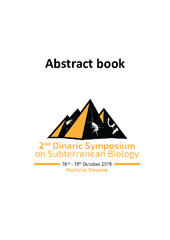Приказ основних података о документу
Phototrophic biofilms in Serbian caves: exploration and features
| dc.creator | Popović, Slađana | |
| dc.creator | Krizmanić, Jelena | |
| dc.creator | Vidaković, Danijela | |
| dc.creator | Karadžić, Vesna | |
| dc.creator | Nikolić, Nataša | |
| dc.creator | Pećić, Marija | |
| dc.creator | Subakov-Simić, Gordana | |
| dc.date.accessioned | 2021-05-13T20:34:16Z | |
| dc.date.available | 2021-05-13T20:34:16Z | |
| dc.date.issued | 2019 | |
| dc.identifier.isbn | 978-961-290-538-5 | |
| dc.identifier.uri | http://www.dinaric-symposium.org/file/AbstractBook_FINAL.pdf | |
| dc.identifier.uri | https://cer.ihtm.bg.ac.rs/handle/123456789/4617 | |
| dc.description.abstract | Phototrophic biofilms can be found in different habitats, including subterranean ones, such as caves. In caves, they thrive in the presence of daylight at the entrances, or in the vicinity of artificial light inside, and are usually very heterogeneous. For the purpose of this study, biofilm sampling from stone substrata was performed in 15 caves (mostly entrances) to examine biofilm characteristic and features, as well as to record the main phototrophic groups. Cyanobacteria, Bacillariophyta and Chlorophyta were the main phototrophs recorded. Cyanobacteria were, according to morphological characteristics, additionally divided into coccoid, simple trichal and heterocytous forms. Biofilms were sorted according to the degree of development and moisture (taking into account free seeping water and water bound in extracellular polymeric substances (EPSs)). Other parameters, namely the water content and content of organic/inorganic matter were determined too. According to the principal component analysis (PCA), Bacillariophyta and Chlorophyta were usually dominant in thin biofilms: while Chlorophyta were connected with dry thin biofilms, Bacillariophyta were abundant in thin biofilms constantly moistened by seeping water. Cyanobacteria dominated in thick and EPSs rich biofilms that also were positively correlated with light intensity and higher values of chlorophyll a. Biofilms were also sorted according to colour, where certain colours or colour assemblages corresponded to whole divisions, cyanobacterial groups or even only one taxon. Chlorophyta rich biofilms were mostly green, only few of them yellow and orange, while those where Cyanobacteria accounted as the most abundant, were very colourful (red, purple, blue, yellow, brown), for which usually only one species was responsible. Scanning electron microscopy (SEM) has additionally helped us to distinguish different biofilm types and their morphology better and enabled detailed analysis of distribution, shape, size and orientation of biofilm constituents. The biofilm rich in Cyanobacteria with calcified filaments occurred as particularly interesting for SEM exploration. | sr |
| dc.language.iso | en | sr |
| dc.publisher | Postojna, Slovenia : Organizing Commitee, 2nd Dinaric Symposium on Subterranean Biology | sr |
| dc.rights | openAccess | sr |
| dc.rights.uri | https://creativecommons.org/licenses/by/4.0/ | |
| dc.source | Abstract book - 2nd Dinaric Symposium on Subterranean Biology | sr |
| dc.subject | Phototrophic biofilms | sr |
| dc.subject | caves | sr |
| dc.subject | Cyanobacteria | sr |
| dc.subject | Scanning electron microscopy (SEM) | sr |
| dc.subject | biofilms | sr |
| dc.subject | principal component analysis (PCA) | sr |
| dc.title | Phototrophic biofilms in Serbian caves: exploration and features | sr |
| dc.type | conferenceObject | sr |
| dc.rights.license | BY | sr |
| dcterms.abstract | Субаков-Симић, Гордана; Пећић, Марија; Николић, Наташа; Караджић, Весна; Поповић, Слађана; Кризманић, Јелена; Видаковић, Данијела; | |
| dc.citation.spage | 48 | |
| dc.citation.epage | 48 | |
| dc.description.other | 18th – 19th October 2019, Postojna | sr |
| dc.identifier.rcub | https://hdl.handle.net/21.15107/rcub_cer_4617 | |
| dc.identifier.fulltext | https://cer.ihtm.bg.ac.rs/bitstream/id/20375/4617.pdf | |
| dc.type.version | publishedVersion | sr |


